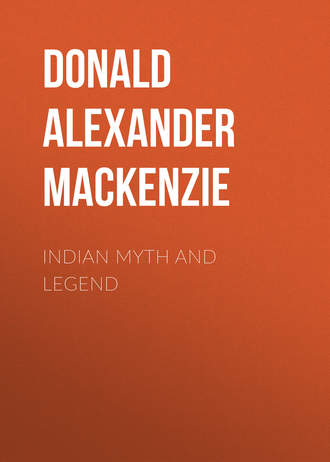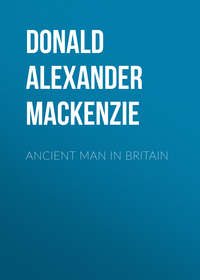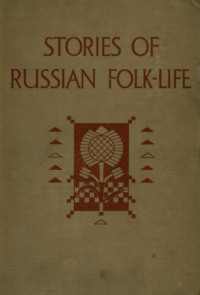 полная версия
полная версияIndian Myth and Legend
284
Behar.
285
A daughter of Drupada who exchanged her sex with a Yaksha. She was a reincarnation of the Princess Amba of Kasi, who, with her two sisters, was captured by Bhishma at the swayamvara. Her sisters were the mothers of Pandu and Dhritarashtra.
286
No widows were burned with their husbands, for the Satí (or Suttee) ceremony had not yet become general in India; nor did the Brahmans officiate at the pyres.
287
Royal territory.
288
The Easter full moon.
289
Here we meet with the familiar father-and-son-combat theme of which the stories of the Persian Sohrab and Rustem, the Germanic Hildebrand and Hadubrand, and the Celtic Cuchullin and Conlaoch are representative variants. Arjuna had effected a temporary exogamous marriage according to matriarchal customs.
290
Offerings.
291
Indra's heaven.
292
Celestial weapon.
293
The south-eastern division of Central India.
294
An incarnation of Manu, the first lawgiver.
295
It was a religious necessity to have offspring. A son performed the funeral rites which rescued his father's soul from hell.
296
The ceremony at which a princess made public choice of a husband from among a number of suitors gathered together.
297
Two of the ten Rishis (saints) who were sons of Bráhma. Narada was a messenger of the gods. Parvata was his great rival.
298
Indra wonders that no battle-slain heroes are arriving at the Indian Valhal.
299
At the period the poem was composed there were only four “guardians”; later there were eight.
300
Evidently the zenana system was in vogue prior to the Mohammedan conquest.
301
Death by hanging was not regarded as a special disgrace.
302
Deities cast no shadows, they never perspired, nor did their feet touch the ground when walking. Their eyes never winked.
303
Heaven, earth, and the underworld.
304
Dowson regards the demon Kali as the personification of the Kali Yuga.
305
The ceremony of purification included the sipping of water and the washing of feet.
306
Ayodhyá signifies “invincible” city. It is identified with the modern Oude.
307
The power of a curse is illustrated in Southey's Curse of Kehama.
308
A (not) soka (sorrow). This beautiful tree has exquisitely coloured and abundant blossom, varying from rich orange red to primrose yellow. It is sacred to Siva.
309
They are coloured red, white, and blue.
310
Rutting elephants. The seasonal juice is odorous, and issues from minute holes on each side of the elephant's temples.
311
Manibhadra, the demi-god, was worshipped by travellers, and resembles Kuvera, god of wealth.
312
A curious glimpse of Hindu ideas regarding demi-gods or demons.
313
This serpent was a demi-god with human face and hands. It ruled its kind in the underworld, and recalls the Egyptian king serpent in the story of the shipwrecked sailor.—See Egyptian Myth and Legend. It is also called Vasuka and Shesha.
314
Oudh.
315
The moon is masculine, and the marriage occurs at a certain phase. In Egypt the moon is male, but was identified with imported female deities. In Norse mythology Mani is moon god; there was, however, an earlier moon goddess, Nana. In Ireland and Scotland the moon was not individualized—that is, not in the Gaelic language. The words for moon in A. Saxon and German are masculine; in Gaelic they are feminine.
316
The Gaelic Diarmid had similarly a beauty spot on his forehead. Women who saw it immediately fell in love with him.
317
Dasarna, “Ten Forts”, in the south-eastern part of Central Hindustan.
318
A Bráhman village settlement.
319
Ten twists or “eddies” of hair called A-vartas—one on forehead, two on breast, one on each flank hollow, &c.
320
This recalls: “He came even unto them.... The driving is like the driving of Jehu the son of Nimshi; for he driveth furiously.”—2 Kings, ix, 20.
321
The Indian peacock is sensitive to rain, and goes round “dancing” when it is coming on.
322
The powers given Nala by the gods as marriage gifts are here illustrated.
323
A part of the ceremony of purification. The mouth was washed after eating, drinking, expectorating, slumbering, &c.
324
According to the laws of Manu, second marriages were unlawful. Apparently, however, they were permissible at the early period of the poem, at least in some districts.
325
Heaven, the earth, and the underworld.
326
A sign of divine approval and favour.
327
Pron. val-mee´kee.
328
The kingdoms of Oudh and North Behar.
329
Pron. a-yõd´hya.
330
Easter full moon.
331
As we have seen, Arjuna and an army accompanied the white horse which was sacrificed in the Mahábhárata.
332
The spirits of ancestors.
333
The Vedic deities.
334
Pron. rah´va-na.
335
He is called a Rakshasa king in the Ramayana. Ravana appears to be the Brahmanical conception of Vritra, the ruler of the Danavas or Asuras. Lanká is Ceylon.
336
Father and mother.
337
The fighting Rakshasas of the Mahábhárata are all males. Here the female—the mother of demons—is prominent, as in Beowulf and typical Scottish stories.
338
A Gaelic axiom says, “Every weapon has its demon”.
339
“The remains of the capital founded by Janaka, and thence termed Janakpur, are still to be seen, according to Buchanan, on the northern frontier at the Janeckpoor of the maps.”—Note to Professor H. H. Wilson's translation of the Uttara Rama Charita.
340
Pron. ky-kay-yee´.
341
Nasik. About 100 miles from Bombay.
342
Names of the wives of Vishnu and Shiva.
343
Pron. Jata´yus.
344
Among the Nilgiri mountains.
345
These apes are the incarnations of the Vedic deities who sojourned on earth according to Vishnu's command.
346
Also “Adam's Bridge”. The green Celtic fairies are similarly credited with making island chains and long jutting promontories which stretch out from opposite shores of arms of the sea.
347
Like Hydra against which Hercules fought.






